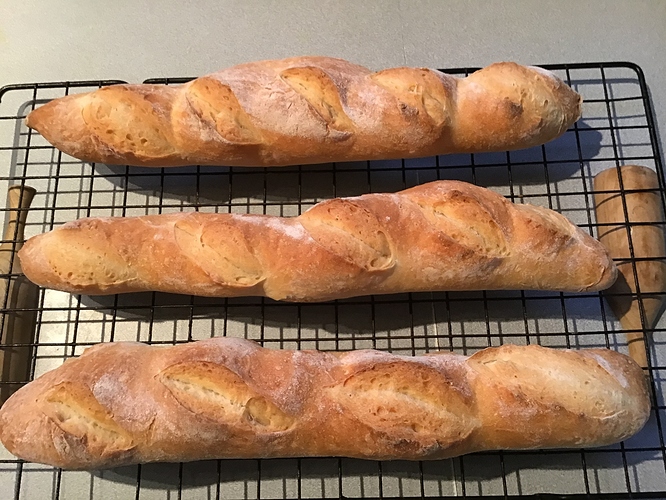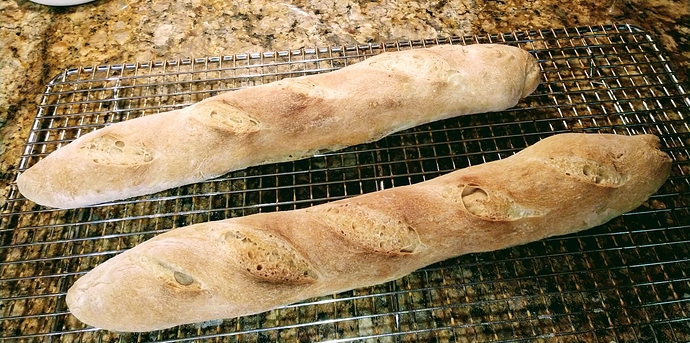It would be impossible to really understand how to shape the baguettes if you don’t want to watch the video. I have read instructions and scratched my head before. The video made it possible for me to understand the process. I guess I am a visual learner.
Wanted to try this recipe as it starts with a poolish and I’ve always been curious to see how those tasted. I followed everything in the video to a T and must say the bread was way underproofed which gave it little flavor, dense crumb, and the awful split on the side near the bottom of every loaf. I’d definitely not handle the dough as much as is suggested. Maybe do a few minute knead or put in mixer for a few minutes on low speed and let it rise for 2 hours before trying to shape it.
I know what you mean! I don’t learn from videos very well. I do better with specific written instructions. Comparing what I’ve seen to pics about what it should be—those help me learn.
It’s interesting to try to figure out how various people learn. I know, because I did it for more than twenty years at school. 
This is really a great recipe, Eric. Thank you. Using poolish seems to improve the flavor quite a bit. Since we are currently going through a heat wave, we baked the bread outside on our Webber gas grill on a pizza stone. We covered the bread for the first 6 minutes with an aluminum baking pan. It worked great.
Am I the first to see the conversions for the poolish are off? 125g of water is a 1/2 cup. But 125g of flour is a full cup? Is this correct?
It’s correct. Water is almost twice as heavy as flour, for the same volume. This stuff can be confusing at first but you get the hang of it over time.
I made the french baguettes according to the recipe. looks very nice but not enough holes in the center. what am i doing wrong??
looks really good… bravo…
So… You have not given much to go on for troubleshooting 
So many variables in flour (measurement, type … you kitchen and THE day) and hydration.
Generally, the flour to water ratio (hydration) is a big part of the “big hole” equation. That you followed the recipe exactly does not equate to absolute success.
What type of flour?
Yeast or starter
Fermentation, i.e. bulk, i.e. did you go by look and feel or recipe time?
A bit more info will help. But, if you choose instead to give it another try, change 1 thing at a time:
hydration
type of flour
timing.
Some more thoughts … I am making baguette today and was reviewing this recipe plus Trevor Wilson (Breadwerx) sourdough recipe for beginners. I typically make the Breadwerx recipe and bake 1/2 recipe one day and 1/2 another.
But, as you noted you made the Breadtopia recipe exactly, I’m thinking you used commercial yeast vs natural leaven. BUT, the Breadwerx recipe includes some good information on the why/how of hydration and bulk fermentation times that affect crumb so that might be a helpful reference for how to adjust those to get the result you want. Trevor also uses a different shaping technique … an option if you want to try that, as well.
Additionally, I did watch the video with the Breadtopia recipe and at the end, Eric notes that he didn’t get exactly the crumb he wanted (visually) although taste was excellent. And he discusses things he could work with to achieve a different crumb.
Thank you Liz. i think it’s the water. i used regular all purpose flour and the poolish plus dry yeast. but the poolish was a little dry when i made it. i will try again tomorrow.
i do not make sourdough just regular baguettes. ( i like sourdough but not my hubby)
thanks again Liz, your help is very much appreciated. 
These turned out beautifully! Chewy, crunchy yummy goodness. Reminded me of the bread I grew up eating in Newark, NJ, and manhattan. Thank you!
Just made these using an organic French T55 flour. Dough was way too wet! By my calculation recipe hydration level is 81%. Baguettes were ugly not surprising given it was my first time trying to make them. Flavor however was excellent. Had with some cave ripened Brie. Awesome combo.
I certainly blew it calculating the hydration level, was actually 63%. 2nd batch of baguettes made at 55% hydration with Francine Organic T55 flour came out perfect. I am amazed how much more flavor I am getting from the French flour than from domestic flour. I am also surprised by the difference in the texture or the flour itself as it feels different than any other flour I’be used. Hard to explain.
They look great.
Thanks!
For those wanting written instructions, I transcribed the video above… Perhaps it will be helpful to those who don’t have their iPad in the kitchen.
Instructions
Night before:
- Combine the Poolish or sourdough starter ingredients, mixing well. Cover, and leave out at room temp overnight. Note: Dough will be shaggy but fairly stiff.
Morning of:
-
Poolish/sourdough will be bubbly and slack, very sponge-like.
-
Add warm water to the Poolish/Sourdough mix and stir to combine.
-
Stir together the dry ingredients and add to the wet. Stir with dough whisk until shaggy dough forms and most of the flour has been absorbed into the dough ball. Finish incorporating everything by hand and form into a smooth ball. Let sit, covered, in the bowl for 10 minutes.
-
Stretch and fold dough by pinching one edge and folding in towards the center of the ball. Repeat 15 times, moving around the edge of the ball. This should take 10-20 seconds. Turn ball over when finished, Cover and let sit another 10 minutes. Repeat 4 times. Tip: use wet fingers when pinch-pull-folding to avoid dough sticking to fingers.
-
Let sit covered for 1 hour. Punch down dough like focaccia, poking fingertips into dough to release air. Scrape dough together with a scraper to form a ball. Weigh the ball and divide dough into thirds. Fold together each third to incorporate small bits into the dough ball.
-
On a floured surface, slightly flatten the dough to an oblong about 10" long. Fold each end towards the middle, pressing firmly to adhere. Fold top edge towards the center and push down to seal, rotate dough 180° and repeat. There should be a total of 4 folds. Push fingertips into dough to ensure the folds adhere together, and pat into an oblong about 6" long. Repeat with remaining dough to form 3 baguettes blanks. Turn over (seam side down), cover with damp towel, and let rest 15 minutes.
-
Once rested, flatten one blank slightly so it’s an oblong rectangle. Working from the top left corner, fold about 1" of the dough along 1/2 the top edge down towards the middle. Repeat from the right corner. Go back to the left corner and repeat the fold, bringing the top edge down towards the bottom edge, creating a snail-type roll. Repeat from the right corner. Once rolled up, turn seam side down and roll back and forth to elongate to desired length, tapering the ends if desired.
-
Flour a baking or pastry cloth (linen or canvas “koosh”) well, and place each baguette on the cloth starting at one end, creating a fold of fabric between each to prevent sticking and control the rise side to side. Cover with remaining fabric and let rise 1 hour.
-
Place an oven safe pan in bottom of oven and preheat oven to 475ºF for about 35 minutes during the rise. If using a baking stone, put it in while oven is cold. If using a baguette pan, no need to preheat it.
-
Using the fabric, flip each baguette onto a lightly floured board (cutting board will work), then onto either the pan or onto a parchment lined baking sheet (to transfer to the baking stone). Use the edge of the board to straighten loaves on the parchment if using.
-
Score the loaves with a very sharp knife or razor blade, 5 long overlapping cuts 1/4" deep and about 1/3 the length of the loaf at a 45° angle. Put into preheated oven. If using a baking stone, slide the parchment onto the stone. Add 1/2 cup of water to the hot pan in bottom of oven to create steam while baking. Bake 15-17 minutes (until golden brown). Cool 1 hour on a rack, and enjoy.
Make the baguettes this morning. I used my sourdough starter for the poolish. They turned out awesome!!! A very good recipe!!!



